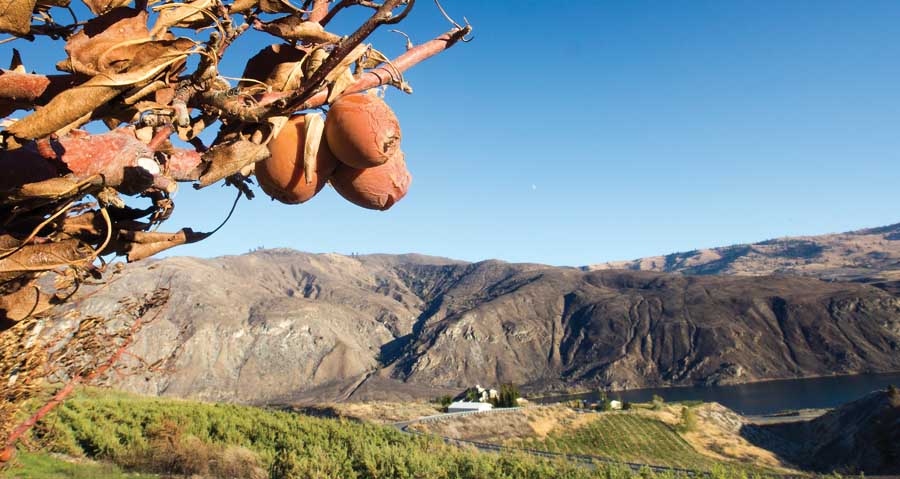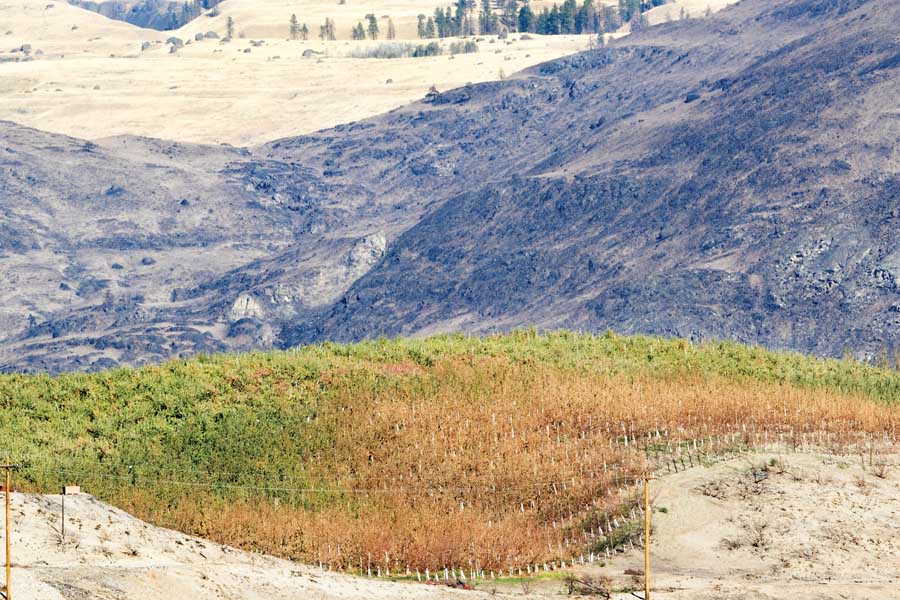
One of about 6,000 trees lost to fire by Reggie Collins, chief executive officer of Chelan Fruit. His orchards overlook the Columbia River outside of Chelan, Washington. (TJ Mullinax/Good Fruit Grower)
When a wildfire skirted the edges of Chelan, Washington, in August, Reggie Collins suffered more than one loss: In addition to the destruction of Plant
No. 1 at Chelan Fruit Cooperative, where Collins is chief executive officer, he also lost about 6,000 trees in his own orchards.
The fire burned 4,500 apple trees—Fuji, Gala and Braeburn—and about 1,500 Santina and Rainier cherry trees.
And like most growers, Collins didn’t have insurance on the trees, just on the crop in the event of a major loss.
“You lose on the trees, the income those trees would have produced 10 to 15 years,” he said. “I didn’t have any insurance for the irrigation system that was lost in the rows. Deer fencing and posts that surrounded my property are not insurable.”
But, he added, noting that more growers suffered wildfire damage in north-central Washington last year, “It could have been a whole lot worse.”
There are programs available to help growers who’ve suffered damage to trees and property—and not just to their crops—in a natural disaster, though there are limits to who qualifies.
The U.S. Department of Agriculture Farm Service Agency’s Tree Assistance Program (TAP), which was authorized in the 2014 Farm Bill, provides financial assistance to qualifying growers to replant or rehabilitate trees and vines damaged by natural disasters.
The program pays 65 percent of the actual cost of replanting and/or 50 percent of the actual cost of rehabilitation, after adjustment for normal mortality of 15 percent.
So, a grower who lost 100 trees in an orchard to wildfire would be reimbursed 65 percent of the cost to replant 85 trees or 60 percent of the cost to rehabilitate 85 trees, with the remaining 15 trees considered normal mortality and ineligible.
Growers must have owned the eligible tress or vines when the disaster occurred, but they are not required to own the land on which the trees and vines are planted.
TAP caps payments per grower at $125,000 per year and acreage to replant or rehabilitate at 500 acres. The average adjusted gross income for the grower or entity also cannot exceed $900,000 to be eligible for the program.
The Emergency Conservation Program (ECP), also administered by FSA, provides emergency funding to farmers to rehabilitate land damaged by natural disaster and to implement emergency water conservation measures in periods of severe drought.
The program is subject to availability of funds. Locally elected members of FSA county committees inspect damaged land and determine eligibility, then make the request for funding. Unlike TAP, this cost-share program does not have an income eligibility cap.
Growers can seek cost-share assistance to replace or rehabilitate wildfire damages to things such as fencing, irrigation equipment, and trees planted for windbreak.

Orchards burned by the Chelan complex fire in Chelan, Washington on September 23, 2015. (TJ Mullinax/Good Fruit Grower)
“There are a number of programs for farmers and ranchers who need assistance in good times and bad,” says FSA Administrator Val Dolcini. “We’re encouraging farmers and ranchers who’ve been impacted by wildfires to make sure they’re keeping good records so that when they come into their local FSA office, they have a good history of what they’ve been growing.”
On the crop insurance side, USDA’s Risk Management Agency has a new option available to growers—in addition to the basic catastrophic, buy-up, and premium policies—who want to protect themselves in the event of a disaster.
The Whole Farm Revenue Protection pilot program provides a safety net for all commodities on a farm under one insurance policy.
The program is available to growers throughout the country, but is tailored to farms with specialty or organic commodities, or farms focusing on local and direct-market sales. Subsidy levels and premium discounts increase with the number of crops grown on the farm.
The liability limit is $8.5 million. WFRP coverage can be purchased alone or with additional federal crop insurance policies.
In addition, the Supplemental Coverage Option and the Actual Production History Yield Exclusion are now available to some fruit growers for the 2016 season in select counties. (More info about supplemental USDA risk management coverage options.)
SCO is an area-based policy endorsement that can be purchased to supplement an underlying crop insurance policy.
It covers a portion of losses not covered by the same crop’s underlying policy.
The APH Yield Exclusion allows farmers, with qualifying crops in eligible counties, to exclude low yields in exceptionally bad years (such as a year in which a natural disaster occurred) from their production history when calculating yields used to establish their crop insurance coverage.
This will allow eligible producers to receive a higher approved yield on their insurance policies through the federal crop insurance program.
Growers should contact their crop insurance agents to discuss options that work best for their particular operations. •
– by Shannon Dininny






Leave A Comment